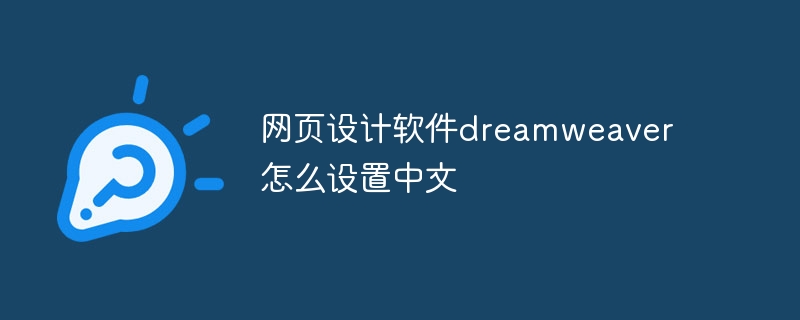How to set Chinese language in web design software Dreamweaver
Setting Chinese in Dreamweaver requires the following steps: Change the interface language to Chinese Simplified or Chinese Traditional. Set the encoding of HTML documents to UTF-8 or GBK. Set the encoding of the CSS document to UTF-8 or GBK. Set the encoding of JavaScript documents to UTF-8 or GBK, and ensure that all related documents use the same encoding setting.

How to set Chinese in Dreamweaver
Step 1: Change the default language setting
- In Dreamweaver, go to Edit >Preferences (Windows) or Dreamweaver >Preferences (Mac).
- In the "Preferences" dialog box, select the "Interface" category.
- In the "Interface" tab, in the "Language" section, select "Chinese Simplified" or "Chinese Traditional" from the drop-down menu.
- Click OK to save changes.
Step 2: Set the encoding for the HTML document
- In Dreamweaver, open the HTML document where you want to set Chinese.
- In the "Document" panel, find the "Encoding" setting.
- Select "UTF-8" or "GBK" from the drop-down menu. "UTF-8" is the recommended Unicode encoding and supports a wider range of Chinese character sets.
- Click "Update" to apply the changes.
Step 3: Set the encoding for the CSS document
- In Dreamweaver, open the CSS document where you want to set Chinese.
- In the "File" menu, select "Save As".
- In the "Save As" dialog box, select "UTF-8" or "GBK" as the "Encoding" setting.
- Click Save to apply changes.
Step 4: Set the encoding for the JavaScript document
- In Dreamweaver, open the JavaScript document where you want to set Chinese.
- For external JavaScript files, in the File menu, select Save As.
- In the "Save As" dialog box, select "UTF-8" or "GBK" as the "Encoding" setting.
-
For embedded JavaScript, in Code view, manually add the following line:
<code><script type="text/javascript" charset="UTF-8"> // 你的 JavaScript 代码 </script></code>
Copy after loginNote: Make sure all related documents use the same Encoding settings to avoid character display issues.
The above is the detailed content of How to set Chinese language in web design software Dreamweaver. For more information, please follow other related articles on the PHP Chinese website!

Hot AI Tools

Undresser.AI Undress
AI-powered app for creating realistic nude photos

AI Clothes Remover
Online AI tool for removing clothes from photos.

Undress AI Tool
Undress images for free

Clothoff.io
AI clothes remover

Video Face Swap
Swap faces in any video effortlessly with our completely free AI face swap tool!

Hot Article

Hot Tools

Notepad++7.3.1
Easy-to-use and free code editor

SublimeText3 Chinese version
Chinese version, very easy to use

Zend Studio 13.0.1
Powerful PHP integrated development environment

Dreamweaver CS6
Visual web development tools

SublimeText3 Mac version
God-level code editing software (SublimeText3)

Hot Topics
 1389
1389
 52
52
 The Roles of HTML, CSS, and JavaScript: Core Responsibilities
Apr 08, 2025 pm 07:05 PM
The Roles of HTML, CSS, and JavaScript: Core Responsibilities
Apr 08, 2025 pm 07:05 PM
HTML defines the web structure, CSS is responsible for style and layout, and JavaScript gives dynamic interaction. The three perform their duties in web development and jointly build a colorful website.
 How to use bootstrap in vue
Apr 07, 2025 pm 11:33 PM
How to use bootstrap in vue
Apr 07, 2025 pm 11:33 PM
Using Bootstrap in Vue.js is divided into five steps: Install Bootstrap. Import Bootstrap in main.js. Use the Bootstrap component directly in the template. Optional: Custom style. Optional: Use plug-ins.
 How to write split lines on bootstrap
Apr 07, 2025 pm 03:12 PM
How to write split lines on bootstrap
Apr 07, 2025 pm 03:12 PM
There are two ways to create a Bootstrap split line: using the tag, which creates a horizontal split line. Use the CSS border property to create custom style split lines.
 Understanding HTML, CSS, and JavaScript: A Beginner's Guide
Apr 12, 2025 am 12:02 AM
Understanding HTML, CSS, and JavaScript: A Beginner's Guide
Apr 12, 2025 am 12:02 AM
WebdevelopmentreliesonHTML,CSS,andJavaScript:1)HTMLstructurescontent,2)CSSstylesit,and3)JavaScriptaddsinteractivity,formingthebasisofmodernwebexperiences.
 How to use bootstrap button
Apr 07, 2025 pm 03:09 PM
How to use bootstrap button
Apr 07, 2025 pm 03:09 PM
How to use the Bootstrap button? Introduce Bootstrap CSS to create button elements and add Bootstrap button class to add button text
 How to resize bootstrap
Apr 07, 2025 pm 03:18 PM
How to resize bootstrap
Apr 07, 2025 pm 03:18 PM
To adjust the size of elements in Bootstrap, you can use the dimension class, which includes: adjusting width: .col-, .w-, .mw-adjust height: .h-, .min-h-, .max-h-
 How to set up the framework for bootstrap
Apr 07, 2025 pm 03:27 PM
How to set up the framework for bootstrap
Apr 07, 2025 pm 03:27 PM
To set up the Bootstrap framework, you need to follow these steps: 1. Reference the Bootstrap file via CDN; 2. Download and host the file on your own server; 3. Include the Bootstrap file in HTML; 4. Compile Sass/Less as needed; 5. Import a custom file (optional). Once setup is complete, you can use Bootstrap's grid systems, components, and styles to create responsive websites and applications.
 How to insert pictures on bootstrap
Apr 07, 2025 pm 03:30 PM
How to insert pictures on bootstrap
Apr 07, 2025 pm 03:30 PM
There are several ways to insert images in Bootstrap: insert images directly, using the HTML img tag. With the Bootstrap image component, you can provide responsive images and more styles. Set the image size, use the img-fluid class to make the image adaptable. Set the border, using the img-bordered class. Set the rounded corners and use the img-rounded class. Set the shadow, use the shadow class. Resize and position the image, using CSS style. Using the background image, use the background-image CSS property.




